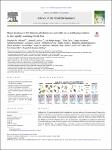Major declines in NE Atlantic plankton contrast with more stable populations in the rapidly warming North Sea
| dc.contributor.author | Holland, Matthew | |
| dc.contributor.author | Louchart, A | |
| dc.contributor.author | Artigas, LF | |
| dc.contributor.author | Ostle, C | |
| dc.contributor.author | Atkinson, A | |
| dc.contributor.author | Rombouts, I | |
| dc.contributor.author | Graves, CA | |
| dc.contributor.author | Devlin, M | |
| dc.contributor.author | Heyden, B | |
| dc.contributor.author | Machairopoulou, M | |
| dc.contributor.author | Bresnan, E | |
| dc.contributor.author | Schilder, J | |
| dc.contributor.author | Jakobsen, HH | |
| dc.contributor.author | Llody-Hartley, H | |
| dc.contributor.author | Tett, P | |
| dc.contributor.author | Best, M | |
| dc.contributor.author | Goberville, E | |
| dc.contributor.author | McQuatters-Gollop, A | |
| dc.date.accessioned | 2023-07-17T10:17:07Z | |
| dc.date.available | 2023-07-17T10:17:07Z | |
| dc.date.issued | 2023-11-10 | |
| dc.identifier.issn | 0048-9697 | |
| dc.identifier.issn | 1879-1026 | |
| dc.identifier.other | 165505 | |
| dc.identifier.uri | https://pearl.plymouth.ac.uk/handle/10026.1/21047 | |
| dc.description.abstract |
Plankton form the base of marine food webs, making them important indicators of ecosystem status. Changes in the abundance of plankton functional groups, or lifeforms, can affect higher trophic levels and can indicate important shifts in ecosystem functioning. Here, we extend this knowledge by combining data from Continuous Plankton Recorder and fixed-point stations to provide the most comprehensive analysis of plankton time-series for the North-East Atlantic and North-West European shelf to date. We analysed 24 phytoplankton and zooplankton datasets from 15 research institutions to map 60-year abundance trends for 8 planktonic lifeforms. Most lifeforms decreased in abundance (e.g. dinoflagellates: −5 %, holoplankton: −7 % decade−1), except for meroplankton, which increased 12 % decade−1, reflecting widespread changes in large-scale and localised processes. K-means clustering of assessment units according to abundance trends revealed largely opposing trend direction between shelf and oceanic regions for most lifeforms, with North Sea areas characterised by increasing coastal abundance, while abundance decreased in North-East Atlantic areas. Individual taxa comprising each phytoplankton lifeform exhibited similar abundance trends, whereas taxa grouped within zooplankton lifeforms were more variable. These regional contrasts are counterintuitive, since the North Sea which has undergone major warming, changes in nutrients, and past fisheries perturbation has changed far less, from phytoplankton to fish larvae, as compared to the more slowly warming North-East Atlantic with lower nutrient supply and fishing pressure. This more remote oceanic region has shown a major and worrying decline in the traditional food web. Although the causal mechanisms remain unclear, declining abundance of key planktonic lifeforms in the North-East Atlantic, including diatoms and copepods, are a cause of major concern for the future of food webs and should provide a red flag to politicians and policymakers about the prioritisation of future management and adaptation measures required to ensure future sustainable use of the marine ecosystem. | |
| dc.format.extent | 165505-165505 | |
| dc.format.medium | Print-Electronic | |
| dc.language | en | |
| dc.publisher | Elsevier BV | |
| dc.subject | Continuous plankton recorder | |
| dc.subject | Environmental indicators | |
| dc.subject | Food webs | |
| dc.subject | North Sea | |
| dc.subject | North-East Atlantic | |
| dc.subject | Marine ecosystem management | |
| dc.subject | Pelagic habitats | |
| dc.subject | Plankton | |
| dc.title | Major declines in NE Atlantic plankton contrast with more stable populations in the rapidly warming North Sea | |
| dc.type | journal-article | |
| dc.type | Journal Article | |
| plymouth.author-url | https://www.webofscience.com/api/gateway?GWVersion=2&SrcApp=PARTNER_APP&SrcAuth=LinksAMR&KeyUT=WOS:001045688700001&DestLinkType=FullRecord&DestApp=ALL_WOS&UsrCustomerID=11bb513d99f797142bcfeffcc58ea008 | |
| plymouth.volume | 898 | |
| plymouth.publication-status | Accepted | |
| plymouth.journal | Science of The Total Environment | |
| dc.identifier.doi | 10.1016/j.scitotenv.2023.165505 | |
| plymouth.organisational-group | |Plymouth | |
| plymouth.organisational-group | |Plymouth|Faculty of Science and Engineering | |
| plymouth.organisational-group | |Plymouth|Faculty of Science and Engineering|School of Biological and Marine Sciences | |
| plymouth.organisational-group | |Plymouth|Users by role | |
| plymouth.organisational-group | |Plymouth|Users by role|Academics | |
| dc.publisher.place | Netherlands | |
| dcterms.dateAccepted | 2023-07-11 | |
| dc.date.updated | 2023-07-17T10:17:07Z | |
| dc.rights.embargodate | 2023-7-18 | |
| dc.identifier.eissn | 1879-1026 | |
| dc.rights.embargoperiod | forever | |
| rioxxterms.versionofrecord | 10.1016/j.scitotenv.2023.165505 |


